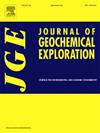Geochemistry and U-Pb dating of the Yahyalı pluton and associated skarn occurrences, SW Kayseri (Central Türkiye): Geodynamic significance and relation to mineralization
IF 3.4
2区 地球科学
Q1 GEOCHEMISTRY & GEOPHYSICS
引用次数: 0
Abstract
The Yahyalı Pluton is an intrusion that intruded into the Yahyalı Nappe in the Eastern Taurus Belt. However, its outcrops are observed in a narrow area due to insufficient erosion depth and few studies have been carried out. This pluton is mainly composed of granite, granodiorite, diorite and monzonite. These facies are predominantly calc-alkaline and partly high-K calc-alkaline series, with an I-type character. The geochemical behaviour of the pluton suggests that mafic magmas of mantle origin have undergone a high degree of fractional crystallization (FC) and may have been partially mixed and/or contaminated by felsic magmas of crustal origin.
In this study, the Yahyalı pluton and associated garnet skarn formations were dated for the first time. Zircon U-Pb dating of samples taken from different levels of the Yahyalı pluton yielded concordia ages of 52.37 ± 0.41 Ma, 53.66 ± 0.30 Ma, 52.59 ± 0.37 Ma and 52.05 ± 0.36 Ma, respectively. In addition, a lower intercept age of 50.1 ± 3.3 Ma (MSWD = 1.4) (Early Eocene) was obtained from garnet skarn formations. Although the pluton has limited outcrops, associated mineralization (Fe and Fe-Cu skarn, Pb-Zn) occurs over an extensive area, suggesting that large parts of the pluton may not have been eroded. This suggests that the Yahyalı pluton is a fertile magma in terms of mineralization and that there is a high potential for skarn, hydrothermal and porphyry-type mineralization associated with the magmatic system at deeper depths in the region.
西南开塞利(中部)叶海拉尔基岩体及其伴生矽卡岩的地球化学和U-Pb定年:地球动力学意义及其与成矿的关系
叶海拉尔岩体是侵入东金牛带叶海拉尔拉推覆构造的岩体。但由于侵蚀深度不足,其露头分布范围较窄,研究较少。该岩体主要由花岗岩、花岗闪长岩、闪长岩和二长岩组成。这些相以钙碱性为主,部分为高钾钙碱性系列,具有i型特征。该岩体的地球化学特征表明,幔源基性岩浆经历了高度的分离结晶(FC),并可能被地壳源的长英质岩浆部分混合或污染。本文首次对叶海拉尔岩体及其伴生的石榴石夕卡岩组进行了年代测定。叶海拉尔岩体不同层位样品的锆石U-Pb测年结果显示,锆石年龄分别为52.37±0.41 Ma、53.66±0.30 Ma、52.59±0.37 Ma和52.05±0.36 Ma。此外,石榴石矽卡岩组的截距年龄较低,为50.1±3.3 Ma (MSWD = 1.4)(早始新世)。虽然该岩体的露头有限,但伴生的矿化(铁、铁、铜夕卡岩、铅锌)分布在广泛的区域,表明该岩体的大部分可能未被侵蚀。这表明叶海拉尔岩体在成矿作用方面是一种丰富的岩浆,该区深部存在与岩浆体系相关的矽卡岩、热液和斑岩型成矿的潜力较大。
本文章由计算机程序翻译,如有差异,请以英文原文为准。
求助全文
约1分钟内获得全文
求助全文
来源期刊

Journal of Geochemical Exploration
地学-地球化学与地球物理
CiteScore
7.40
自引率
7.70%
发文量
148
审稿时长
8.1 months
期刊介绍:
Journal of Geochemical Exploration is mostly dedicated to publication of original studies in exploration and environmental geochemistry and related topics.
Contributions considered of prevalent interest for the journal include researches based on the application of innovative methods to:
define the genesis and the evolution of mineral deposits including transfer of elements in large-scale mineralized areas.
analyze complex systems at the boundaries between bio-geochemistry, metal transport and mineral accumulation.
evaluate effects of historical mining activities on the surface environment.
trace pollutant sources and define their fate and transport models in the near-surface and surface environments involving solid, fluid and aerial matrices.
assess and quantify natural and technogenic radioactivity in the environment.
determine geochemical anomalies and set baseline reference values using compositional data analysis, multivariate statistics and geo-spatial analysis.
assess the impacts of anthropogenic contamination on ecosystems and human health at local and regional scale to prioritize and classify risks through deterministic and stochastic approaches.
Papers dedicated to the presentation of newly developed methods in analytical geochemistry to be applied in the field or in laboratory are also within the topics of interest for the journal.
 求助内容:
求助内容: 应助结果提醒方式:
应助结果提醒方式:


